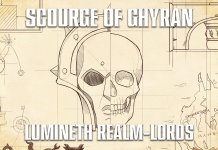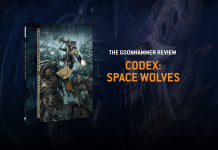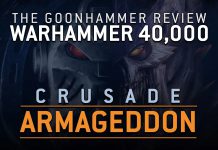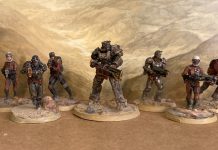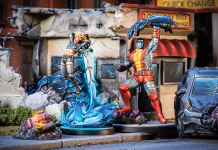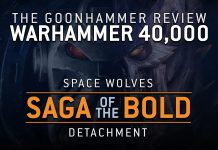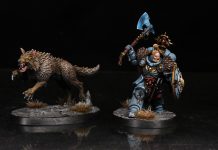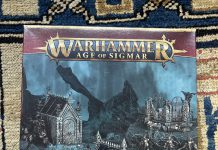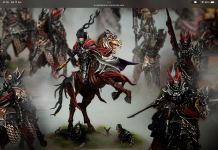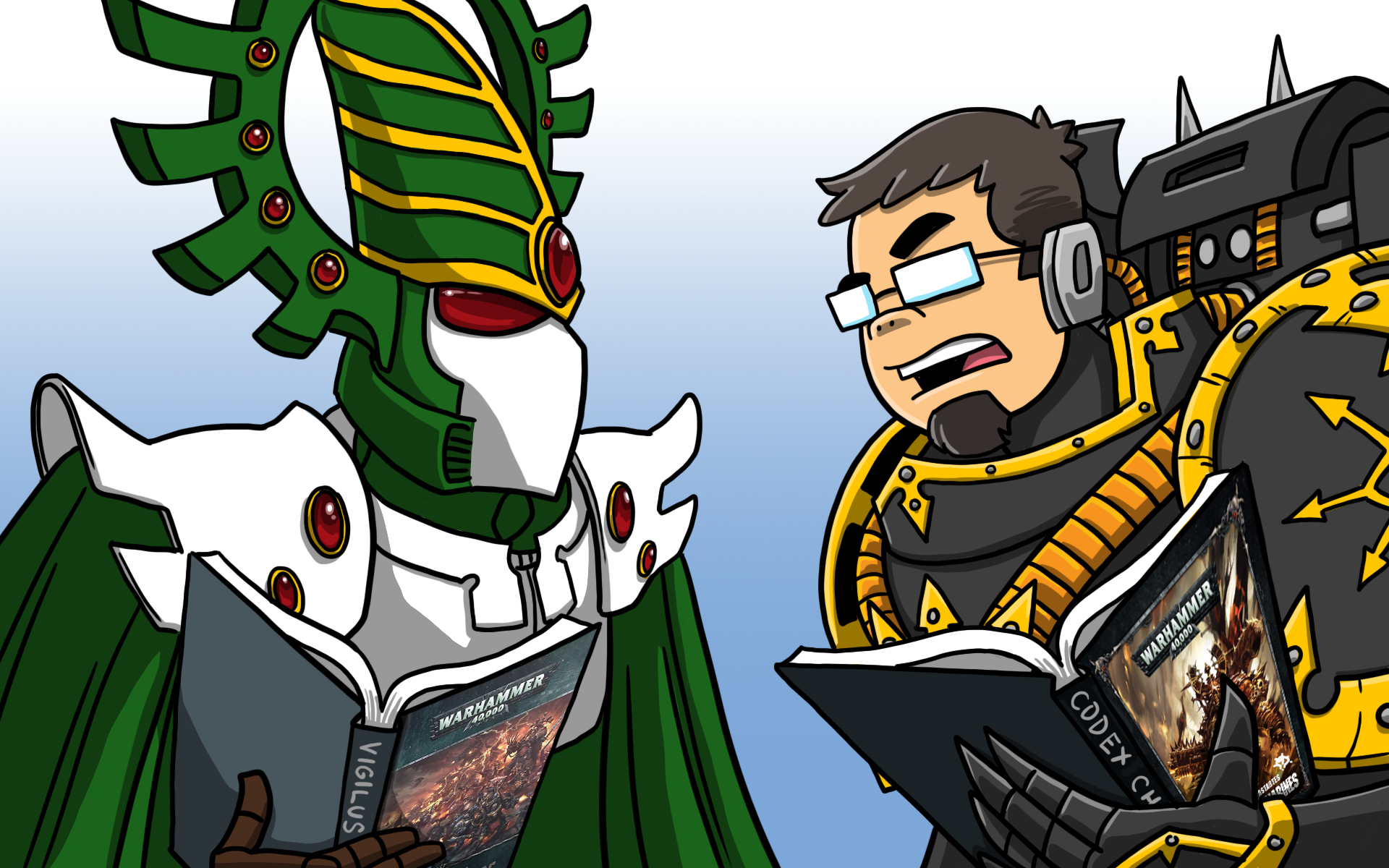As Games Workshop releases new kits, rules, and books for Warhammer 40,000, we’ll be there to review them. In our Reviews, we take a look at the contents of the new product and what it means for you, whether you’re going to be playing with the new faction and rules, or potentially playing against them. This week, One_Wing and TheChirurgeon are reviewing the new Codex: Chaos Knights, and talking strategy for using the units therein.
Something wicked (and extremely large) this way comes. After being forced to limp along with Index entries, Chaos Knights got thrown a (very paltry) bone last year with the Renegade Knights mini-codex, which gave them access to a warlord trait and a pair of stratagems. As a result, they’ve been forced to watch as Imperial Knights players had all the fun dominating tournaments and warping the meta with their massive engines of destruction while Chaos Knights went unused. Well no more! With the release of the Chaos Knights Codex, Chaos has been granted its own suite of warlord traits, relics, subfactions, and stratagems to flesh out its own knights, as well as a new dual kit with extremely sick digitigrade legs and a new gun.
So is this new Codex a meta-warping, game-changing monster? Or full of dull entries into the Chaos unit stable? Join us as One_Wing and TheChirurgeon dive into the new release and examine the good, the bad, and the ugly about the new book.

The Army
The Chaos Knights Codex revises the content from the Chapter Approved 2018 update of the Renegade Knights Codex and adds two new units, both of which are built from the new Chaos Knight Dual kit: The Rampager, a close-combat knight armed with a Reaper Chainsword and Thunderstrike Gauntlet, and the Knight Desecrator, which comes armed with a Las Destructor and a close combat weapon of your choice. In total, that gives Chaos Knights two more options than loyalists, plus more customisation on their standard knights.
The full list of available units in the book is:
- War Dogs (Chaos Armigers)
- Knight Despoiler (A “standard” knight, able to double up on weapon options)
- Knight Tyrant (A Chaos Dominus)
- Knight Rampager (A new, close-combat Chaos Knight)
- Knight Desecrator (A new Chaos Knight with a close combat weapon and a laser destructor)
As with all modern Codexes, it isn’t just the units we’re here for – there’s a whole set of Faction Traits, Warlord Traits, Stratagems and Relics. We’ve done out best to digest these, and we think that this book can be best summed up as follows:
| Strengths | Weaknesses |
|---|---|
| Extremely powerful faction traits | Underwhelming warlord traits compared to Imperials. |
| Chaos gains the "toolbox" of stratagems that Imperial Knights do. | Single Knights less powerful. |
| Some exceptionally powerful specific "counters" in the relic section. | Less clear where they fit in the superfaction. |
Core Rules
Traitoris Lances
Just like Imperial Knights, Chaos Knights get a varying amount of CP from Super Heavy detachment depending what’s in them. 3 War Dogs gives you 0, at least 1 TITANIC Knight gives 3CP and 3 TITANIC units gives 6CP. We think Chaos Knights want to be in full detachments quite a bit more than Imperials do, so expect to see the “middle” build of two war dogs and a TITANIC a bit more.
Traitoris Ambitions (Faction Traits)
If you have a full “Super Heavy” detachment of Chaos Knights and they share a sub-faction, they gain the appropriate “Ambition”.
Unlike Imperial Knights, where a lot of the variety and customisation came from the wide spread of faction traits available to them, Chaos Knights have been grouped into just two larger buckets that grant more flexibility within them. These are the Iconoclast Households, twisted mirror of the Questor Imperialis and the Infernal Households, servants of the Dark Mechanicum. On top of this, you can declare some of your Knights to be Dreadblades, the equivalent of Imperial Freeblades. Each of these offer you some quite different benefits to turbo-charge your gigantic spike-bot.
Iconoclast Households
Iconoclast Households are designed for people who want to charge their Knights straight at the enemy and reap a terrible toll in close combat. Their Ambition trait gives them two benefits in the first round of combat when they charge, get charged or heroically intervene. The first is an additional attack, which is always nice to have, but we would argue that the second benefit, improving the AP of their weapons by one, is the real bonus.
Both of these buffs work exceptionally well with the “multiplier” attacks that most knights have (Titanic Feet on the large ones and Sweep Attacks from War Dogs), as the additional attack becomes multiple extra hit rolls and the AP improves to a very impressive -3. These combine to makes a spectacular difference to damage output against some important targets.
When facing a normal knight, T7 vehicles with a 3+ save can normally survive being in combat for one turn, as a round of kicking won’t quite take them down – the average damage from a series of stomp attacks is about 7W, absent any other buffs. The extra three hit rolls combined with the additional AP push the likely damage up to 11W, more than a 50% increase in output and at a range where even the slightest spike (or judicious use of a reroll) threatens to take out something like a Wave Serpent in a single round of combat. Titanic Feet are the biggest winner here, but the “strike” attack from Warglaives is a close second, as getting a 5th attack and -4AP again takes them to the point where it only takes a marginally above-average roll to start one-shotting vehicles.
The other unique trick that Iconoclasts have is access to a set of three Stratagems that can be used pre-game (up to once each, and only one on each knight) to apply a game-long buff to one of your Knights. These are:
- Vow of Dominance – The model is never wounded on unmodified rolls of a 1, 2 or 3.
- Vow of Carnage – The model gets +1 attack each time it slays 10 models.
- Vow of the Beastslayer – The model re-rolls Wound rolls of 1 against targets with 8+ Wounds
Vow of Dominance is obviously a hugely powerful effect against some armies, and because it’s a pre-game stratagem you can choose to only apply it when needed. The Imperial Knights do have access to this effect, but it’s tied to one of the weakest factions (House Vulker) as a warlord trait. While “Exalted Court” does mean you can easily choose whether to actually have it “active” in a given game, you have to commit to being House Vulker on your army list, and that turned out to be almost never worth it. The opportunity cost for Chaos to have this in their toolkit is way lower, and that makes it extremely good. Knight Tyrants with the “Valiant” loadout (Flamer and Harpoon) seem like they’re potentially a great choice for this, as they also get plenty of incidental benefit from the boost to their melee.
Vow of Carnage is yet another entry in a category of effects that are frequently quite bad (snowball abilities) but unusually it’s powerful enough that there are situations where you want it – specifically when you’ve got a double Gatling Knight in your list and come up against a horde list like Orks, Daemons or GSC. These can often beat Knights by simply outlasting them or bogging them down, but because the kills for this don’t have to be in melee, it’s pretty plausible that by the time you hit combat you could already have racked up a few extra attacks by mowing things down. Adding in the Iconoclast bonus means you’re suddenly tossing around 18-21 attacks on the first round of combat, which is in turn enough that every time you swing you’re probably adding another attack for the next turn. Against the 100+ model hordes that are extremely popular in the current metagame, this actually seems like a seriously legitimate counter on some builds, and the flexibility to apply it on a unit that’s already good (although it has seen a points hike) is a nice boon.
Vow of the Beastslayer is a tiny bit less exciting than the others, but more options are basically always good. While it isn’t flashy, it’s a nice boost to your damage output if large targets are what you need to be killing, and the fact that you can turn it on only when needed is once again very handy.
Customisation is what made the Imperial Knight Codex so powerful, and while overall we don’t thing this book provides quite such potent options for creating a jacked up turbo-knight, Iconoclasts do get some of that same feeling of being able to adapt to the situation via different vows (notably switching between anti-horde or anti-vehicle via Carnage or Beastslayer).
Each of the two big household types gets four dedicated Stratagems, but the vows use up 3/4 for Iconoclasts, leaving only one – Break the Enemy Line. This is a bit underwhelming – for 2CP you can re-roll hits for all Iconoclasts attacking a given charged target in the fight phase. This is fine, but Trail of Destruction can do the same thing for a single Knight at the same cost, so for this to be worth it you need to have slammed multiple Knights into a target tough enough for you to need to use this. It’s one of those stratagems that will occasionally be very good, but not generally applicable enough to be something you want using up one of your slots.
The odd thing about Iconoclasts is that although the Ambition is aimed at melee combat, it’s so very potent on the Titanic Feet weapon it’s paradoxically probably better on a gun-heavy Questoris knight you’re going to use aggressively rather than one spending points on a melee weapon. This draws you towards the double Gatling build or One_Wing’s new favourite (see later), the double Thermal Cannon.
War Dogs are a different story – the Iconoclast Ambition turbo-charges Warglaives while doing nothing for Helverins. Warglaives have already been growing in popularity in Imperial lists, and we think this might be where they hit the big time – the ambition is exceptional on them, and adding them unlocks it for bigger Knights. Finally, for the Knight Tyrants (as we’ve already alluded to) the Valiant is the big winner – a Castellan will often want to hang back enough that it won’t get much of a boost from this, whereas the Valiant needs to be amongst the enemy sowing carnage anyway.

Infernal Households
Infernal Households are the sinister counterparts of Questor Mechanicus knights, and to represent the mad, changeable whims of the Daemon infested Thrones Mechanicum at the heart of these beasts, Games Workshop’s writers have come up with a very cool Ambition. Unlike pretty much all other Knights, who are “locked in” to a set of choices once a game starts, Infernal Knights can invoke a Daemonic Surge at the start of your movement phase to gain one of three bonuses until your next turn, at the cost of suffering a small amount of damage. For one Mortal Wound you receive a random bonus, or by paying D3 (which in our opinion you’re frequently going to want to) you get to pick between them. The choices are:
- Daemonic Hunger – +2″ Movement, +1 to advances and charges.
- Daemonic Fortitude – +1 Toughness.
- Daemonic Power – Pick a single ranged weapon, and add +1 to its Strength and Damage.
Daemonic Power is obviously the most eye-catching of these, but the others aren’t slouches either. When you need to get somewhere (or squash someone) in a hurry extra movement is nice to have in the back pocket, and both War Dogs and larger Knights are boosted to a relevant “break point” via the application of +1T, making them substantially tougher to take down (although for the Armigers paying 1/6 of their health to do it could be a questionable trade).
We can’t deny, however, that the damage boost is the money shot here. It combos absurdly well with the ever popular Avenger Gatling Cannon, but it’s such a huge upgrade that slapping it on any weapon with a reasonable number of shots is extremely useful, especially if the change in strength makes a difference to your wound rolls. War Dog Helverins get a very nice boost from this – pushing one of their guns to S8 and a ridiculous damage four is worth a bit of pain and the resulting extra faff when it comes to resolving their shots. We have to assume Infernal War Dogs have a terribly unbalanced work out regime, as every last one of them has one Trogdor-like beefy arm carrying a souped up glowing autocannon, while the other looks a bit limp in comparison.
Infernal Households are exceptionally powerful against “balanced” lists, but you do need to be getting value out of the extra damage for it to be worth your while. Lists like horde Orks that rely on buckets of S4 attacks don’t really care about either the extra damage or the toughness boost, so although you don’t have to use it every turn, if that’s what your metagame looks like you might find yourself wishing you were running Iconoclasts.
When the targets are good this absolutely rocks though – absent other modifiers, boosting up a Gatling Cannon improves its damage against multi-wound T8 targets about as much as Endless Fury over a normal Gatling, and if the boost from T6 -> T7 improves your wound roll it’s better.
Mirroring the impact of the Iconoclast Ambition, while the Infernal Ambition is shooting-skewed the fact that it only affects one gun means it’s especially great on Despoilers outfitted to imitate the Imperial Knight Warden (i.e. with a Gatling Cannon and Close Combat Weapon), as this leaves you more points to spend on swole-armed-Armigers. It would also probably be the pick for “Castellan” Knight Tyrants, but sadly as we’ll discuss they still look a bit too pricey to see much competitive play (which might be a good thing, because the idea of trying to shift one with T9 fills us with horror. Well, Wings with horror, TheChirurgeon with sadistic glee).
One concern with the Infernals as compared to the Iconoclasts is that it turns out, even with a Knight profile, you won’t always be able to keep burning D3 mortals forever. Luckily, none of the Infernal strats are tied up in pre-game buffs, and three of the four are pretty spicy:
- 2CP – Bind the Souls of the Defeated: Use in the fight phase, gain a wound back on a 4+ each time you kill a model. Very handy – a standard knight stamping on chaff gets back 3-4 wounds from this, which guns you up for a few more turns.
- 3CP – Pact with the Dark Gods: The dreaded “Taranis” stratagem – when you die, as long as you didn’t explode, get back up on D3 wounds a the end of the phase on a 4+. Mercifully, this is now once per game per knight. It’s still very good.
- 1CP – Daemonic Ammunition: The one miss here – boosts all Heavy Stubbers in a detachment to S5. It’s probably marginally more useful than the Imperium version (which adds -1AP instead) but still not usually worth your CP.
- 2CP – Diabolic Rift:
…and then there’s this nightmare. Use at the start of your opponent’s psychic phase, and for the duration, any psykers that cast within 12″ of any Infernal Knights automatically suffers Perils if they cast. This stratagem is obviously absurdly potent; it’s true that many psychic heavy armies have highly mobile psykers and you’re more likely to force their positioning than actually blow them up with Perils, but dictating where your opponent’s alpha units can and can’t do their thing is always great.This got completely dunked in the Chaos Knight FAQ. It now only causes perils on any double, making it vastly, vastly less effective and probably a waste of your CP a lot of the time. If you have them spare and an entire Thousand Sons castle is in range then maybe still smash the button, but it’s an extremely pale imitation of its former self. RIP Diabolic Rift, 2019-2019.
Our review team is split on whether Infernal or Iconoclast Knights make out better, but we can both agree that these stratagems are extremely good, and give Infernals a good bit of depth.
Dreadblades
The Chaos Knights’ counterpart to Imperial Freeblades, any Chaos Knight (including Infernals and Iconoclasts) can be nominated to be a Dreadblade. Dreadblades have access to Pacts and Damnations. At the start of the game, each Dreadblade can either choose a Pact or roll for two, and must either select two Damnations to go with it (or roll for one). At the start of each turn, a Dreadblade has to roll 2D6; if they roll under their Leadership value, they ignore their Damnations for a turn. Note that the larger Chaos Knights have Ld 9 (72% chance of passing) and War Dogs have Ld 8 (58% chance of passing).
Pacts
- Path to Glory – re-roll hits against Character or Titanic units
- Thunderous Charge – After this model finishes a charge, roll a D6 for each enemy unit within 1″; on a 4+, that unit suffers D3 mortal wounds
- Daemonic Vigour – When generated, roll a D6: On a 1-3, add 2″ to the model’s Movement. On a 4-5, improve its WS by 1. On a 6, improve its BS by 1.
- Knower of Profane Secrets – Add 1 to this model’s Ld characteristic. At the start of the first battle round, if any models with this Pact are on the battlefield, gain 1 CP.
- Galvanised Hull – Weapons that shoot at the model with an AP of -1 have an AP of 0 instead.
- Arch-Fiend – This model can perform Heroic Interventions, and can move up to 6″ when doing so.
Damnations
Note that these are only active for the turn after you fail a Leadership test.
- Forsaken – This model can’t be affected by any stratagems (including re-rolls). Note that if this is one of your Damnations, you get to subtract 1 from your Ld roll each turn.
- Warp-Rage – This model can’t Fall Back and has a BS of 6+
- Volatile Reactor – Roll a D6 at the end of each phase in which this model lost a wound but wasn’t destroyed; on a 4+, it loses another wound.
- Warp Fugue – This model always fights last in the Fight phase.
- Single-Minded Hatred – This unit can only shoot the closest unit in the Shooting phase, and can only charge the closest unit in the Charge phase.
- Defiant Machine Spirit – Subtract 1 from this unit’s to Hit, Charge, and Advance rolls.
Dreadblades are immediately a lot more interesting than Freeblades because unlike their Imperial cousins they don’t appear to lose access to their normal house Ambition and keyword. Freeblades saw basically no play in Imperial Knights, so this is probably for the best, although they may have gone too far the other way – as currently worded, there’s almost no reason you ever wouldn’t choose to nominate one model in each of your detachments to be a Dreadblade, because picking Pacts and Damnations is an optional pre-game choice, meaning you only have to take on the risks of the Damnations if one of the Pacts is helpful.
The most likely candidate for being super handy is “Path to Glory” – if you’re up against another list with Titanic units or powerful characters it’s absurdly great. Galvanised Hull is probably the runner up for most situationally useful – there are a few lists around at the moment that throw out a tonne of AP-1 dakka (the Guillipulsor list and Purge Deredeos being the main culprits) and this is a huge buff when that’s what’s across the table from you.
If you do find yourself wanting one of the Pacts, Volatile Reactor seems like the most benign Damnation, with Warp Fugue likely the next choice unless there are Titanic tier melee threats that are going to be coming after you.
The fact that there’s no cost at all attached to picking a Dreadblade seems like it could be an oversight, but if it stays as is, then these’ll definitely appear, because honestly why wouldn’t they? (N.B. the one actual drawback is that you can’t take the Infernal/Iconoclast specific relics).
The Units
Normally we’d go through each battlefield role quickly covering everything and only talking in detail about the standout units from each, but much like their loyalist cousins the Chaos Knights are confined entirely to the “Lord of War” slot, so our process is ruined, ruined.
Because there are also far fewer units that in a conventional codex, we’ll instead give each of them their own rundown, spending the most time on ones where there are considerable differences to their loyalist counterparts, or which are substantially changed by the new options in the Codex. As we go, we’ll flag up stratagems, relics and traits that we think are especially potent with specific units, then cover any remaining ones in their own section at the end.
War Dogs

Chaos Armigers are what they always were, providing solid, long-ranged firepower for wiping out heavy infantry or light vehicles. Being a single unit allows you to mix and match Helverins and Warglaives in a single slot, but this isn’t likely to create much utility in most games, since as we covered earlier you probably want them to have different Pacts.
Helverins are an interesting unit.The Imperial version has fallen off a lot in popularity after the initial hype (at least partially due to the advent of Prepared Positions), but Chaos armies lack the kind of quality long-range shooting that Astra Militarum brigades and battalions can provide and so there may be a role for them now that Chaos Knights give the broader Chaos faction more options. The big question will be whether their output and durability can match various flavours of Hellforged Contemptor, which are seeing a lot of play at the moment. One important thing to call out is that, in line with the way things have been worded in the new Chaos Space Marines Codex, the Skyreaper Protocols stratagem gets a stealth buff compared to the Imperial version, as the wording is now “you can re-roll hits”, not “re-roll failed hits”. This means that it no longer falls foul of the incredibly stupid order-of-operations rule, and when shooting things that have a hit modifier (i.e. most fliers) you can actually re-roll all the dice you’d want to, not just the 1s and 2s. This, along with their ability to have one of their guns get super pumped up via the Infernal ambition, should hopefully be enough for them to see play.
Warglaives seem like a big winner from this codex – the Iconoclast pact is substantially better for them than any single Imperial Household Trait, and a lot more of the value of the Chaos Knights is baked into the Ambitions, so a cheap way of ensuring that a bigger Knight gets one is more intrinsically valuable. There’s not a tonne to say about them – once you apply the Ambition they look extremely aggressively costed, and this codex could well be their ticket to the big time.
Knight Despoiler
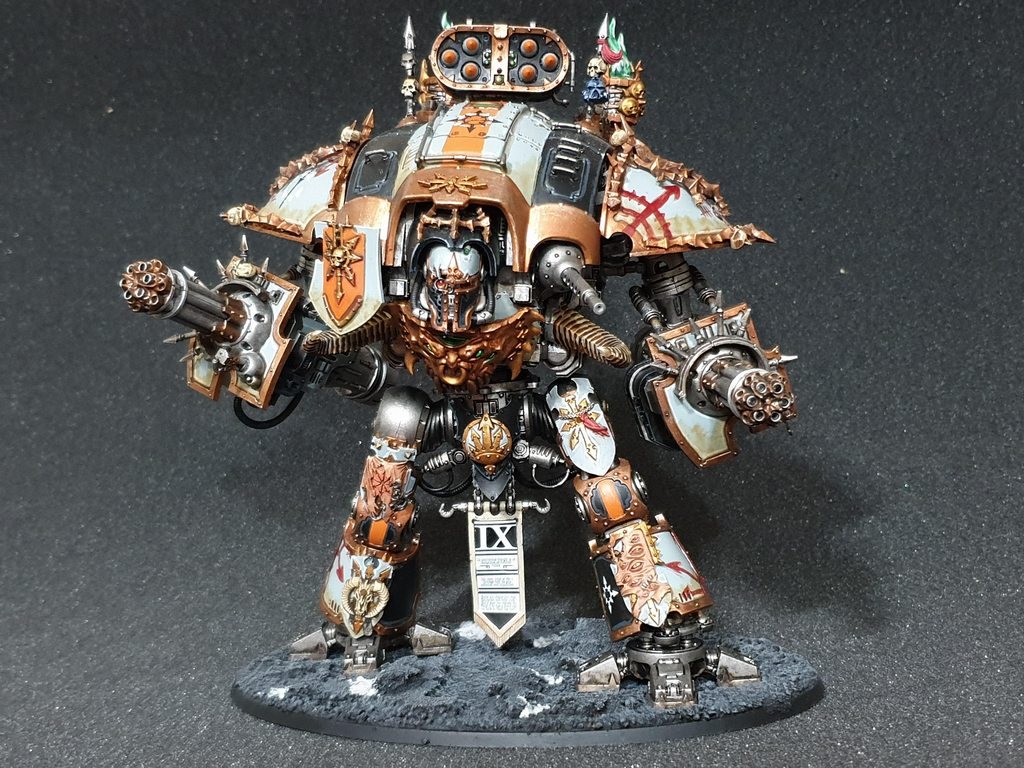
The Knight Despoiler is what you can think of as a “standard Knight,” the equivalent of a Paladin, Errant, Crusader or Gallant, with the main difference being that rather than have a different name for each loadout, you can outfit a Knight Despoiler however you want. The key additional trick this gives you over Imperial Knights is the ability to double up on the same ranged weapon – Imperial Crusaders can take two guns, but they have to be different. The most infamous loadout this permits is giving the Despoiler a pair of Avenger Gatling Cannons, turning your knight into a monster that spits out 24 S6 AP-2 D2 shots per turn. You can double up on close combat weapons, in which case your Despoiler gets +1 Attack and +1 to its WS, imitating the Imperial Knight Gallant (although inexplicably at a 20pt premium compared to Imperials). 8th edition’s mechanics tend to favour specialisation, so being able to take a Knight highly tuned to benefit from specific situations and tricks is an extremely nice tool in the Chaos arsenal.
Somewhat confusingly for people who know the various books well, a whole bunch of the points costs for weapons have changed compared to Imperial Knights and the Renegade Index. Avenger Gatling Cannons have received a (probably sensible) slight hike, going up by 10 points a piece. Both the other big guns have gone down by varying degrees – the RFBC has received a 10pt drop, and the Thermal Cannon a mighty 20. This sums up to mean that Crusader-style loadouts will probably cost about the same as Imperial knights, but the dual Gatling build will cost a bit more than it used to (which is probably for the best given some of the tools you can now combine with it).
The unexpected side effect of this is that a previously barely seen build, dual Thermal Cannons, is suddenly extremely attractive, weighing in at a mere 397pts. That’s honestly kind of outrageous for what it is – sure the Thermal Cannon suffers a bit from high variance, but running three dual Thermal Iconoclast knights seems like an extremely legit build, as your variance will balance out over six cannons, and the Iconoclast boost to your melee gives you an answer to hordes. We think this build could be the hidden gem of the codex. (Note: one of our authors is way higher on this than the other. Wings is going to owe TheChirurgeon a beer if someone doesn’t pull off a big tourney win with this. You know what you need to do, readers.).
Knight Tyrant
The Chaos version of the Dominus-Pattern Knight. Unlike the Knight Despoiler, the Tyrant is limited to the standard Dominus-pattern weapon options, either a Castellan loadout of Plasma Decimator and Volcano Lance or a Valiant loadout of Thundercoil Harpoon and Conflagration Cannon.
Prior to the Codex, these guys had very little going for them compared to their Imperial counterparts. They were big and had lots of guns, but Knight Tyrants lacked the warlord traits and stratagems that would have allowed them to have a 2+ save, 3+ invulnerable save, get back up when destroyed, or target characters without needing line of sight or being the closest model, making them mostly an afterthought. The good news is, those holes have been filled by the Chaos Knights codex. The bad news is that Castellan-style Chaos Tyrants have been pre-emptively hit with the same 100-point price increase and Rotate Ion Shields errata as their Imperial counterparts as a part of the Big FAQ 3’s points changes.
The Castellan has already seen a dramatic drop in play as a result of that points increase, and the same issues extend to the Knight Tyrant, which will have to be markedly better for the same points cost to justify bringing to games. Getting the most out of one also requires a massive investment of CP that Chaos struggles to meet: The army doesn’t have access to the same cheap brigade option that Guard provide, leaving the Red Corsairs detachment as your primary option for generating a lot of CP.
On the other hand, the Chaos Knights book gives close combat knights much more to work with, making a Valiant version of the Tyrant (with a Thundercoil Harpoon and Inferno Cannon) much more attractive.
Knight Desecrator
One of the two new kits exclusive to Chaos Knights, the Knight Desecrator comes with a Laser Destructor and your choice of a Reaper Chainsword or a Thunderstrike Gauntlet. At first glance, the Laser Destructor is a real beast, putting out S14, AP-4 shots. The problem is that its profile has it at Heavy D3 and D6 damage, which means it’s got a lot of variance that’s going to leave you disappointed a good third to two thirds of the time – or it would were it not for the fact that there’s a good relic gun that you will literally always take if you have one in your army.
The ability to grant re-rolls to War Dogs is neat, as they’re generally a lot more attractive as Chaos than Imperials, and the fact that the Desecrator’s gun is a lot higher range than the Imperial Preceptor’s equivalent means sitting one in the back-field with Helverins is way more plausible. Either way round however, you are investing in a Knight that’s a bit less good at murdering stuff in its own right in exchange for War Dog re-rolls, so you need to be making sure you’re getting value from this. We’re somewhat split on how practical this likely is – Wings believes that one of these sitting in the back with a handful of Infernal Helverins could be a pretty nasty firebase, whereas TheChirurgeon thinks you’re going to need to go in hard before this is practical. Realistically, this probably does have a pretty steep hill to climb before it’s worthwhile – Chaos already has quite a few powerful synergy builds it can use, and it’s more likely that what they’ll want from Knights are units with high raw efficiency.
Knight Rampager
Now this guy has it going on. The Knight Rampager is essentially the Chaos Gallant, armed with a Chainsword and Thunderstrike Gauntlet. The Rampager gets the same bonus to its WS and Attacks, plus it gets a new ability that gives it exploding hits on 6s in melee on its Chainsword and Gauntlet. The sheer volume of Chaos Knights stratagems and household benefits that push toward close combat options seems to make this Knight the more attractive of the two new-chassis units, but only getting the exploding hits for Chainsword and Gauntlet attacks is a real downside. As a Warlord however, this guy can be a machine for assassinating large targets where you’ll want to actually use the sword – give him a Khornate Target and he can turn off the invulnerable saves of any unit he hits combat with once per game, which should be more than enough time for him to tear apart any unit. These guys also make ideal Infernal Household Knights as they’re prime targets for the Bind the Souls of the Defeated stratagem. Ultimately the biggest problem these guys have is that Chaos didn’t really need another monster close combat unit, but one of these might be much more survivable than two Lords Discordant.
Wings Note: I disagree quite strongly on this one – I think these are very overcosted. The exploding hits only applying to Chainsword and Gauntlet attacks is a huge negative, as there’s simply not that much out there where you’re going to need more attacks on top of 5 at WS2+ when going after big targets – and if you do, stratagems give you a better way to “punch up”. Not being able to take a top gun is also a random nasty blow that just makes me want to take a Gallant equivalent with Ironstorms instead. Honestly though, because of how cheap you can get a double Thermal Cannon knight, and how deadly they still are in melee thanks to the Iconoclast Ambition, I’m not convinced either melee knight is what Chaos is going to want – especially when you have the choice of taking two and a bit Lords Discordant instead.
The Forge World Knights
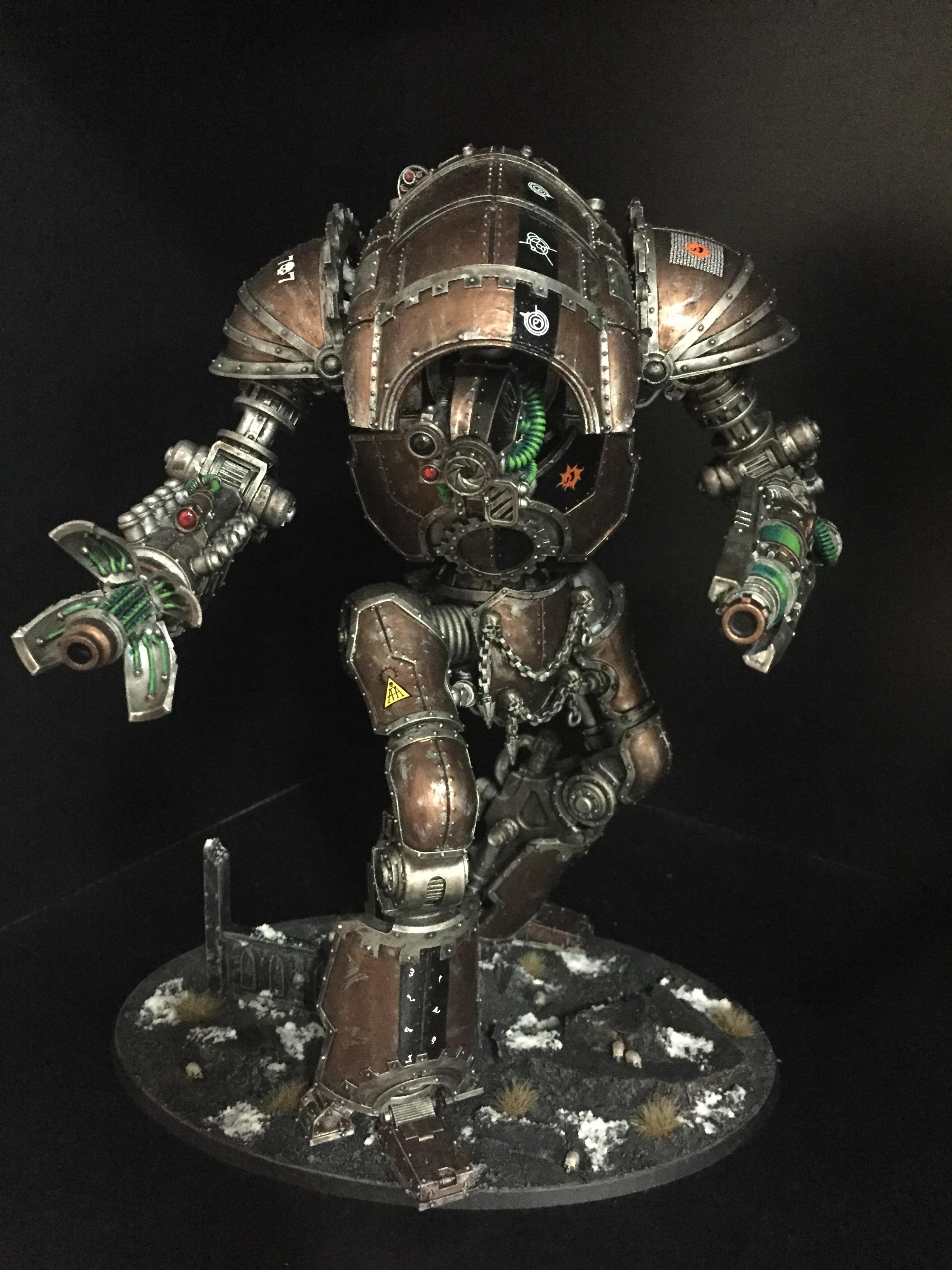
In addition to the five units available in the new Chaos Knights codex, the Questor Traitoris have access to seven other Knights, available as kits from Forgeworld and with rules in Imperial Armour Index: Forces of Chaos. As of this writing however, none of them work with the Chaos Knights — they all have the “Questor Traitoris” or “Dark Mechanicus” keywords instead of “Chaos Knights,” meaning they can’t be in the same detachment as Chaos Knights or benefit from any of their stratagems until they receive errata. That said, much like Imperial Knights’ Forge World entries got errata after their codex released, we expect the same to happen with their traitor counterparts. So in this section, we are assuming that the Forge World units will receive errata such that their datasheets will include the CHAOS KNIGHTS faction keyword.
It’s worth noting that the Forge World Knights have two key advantages over their plastic brethren: The first is that they all have the Infernal Autosimulacra rule, which allows them to heal 1 wound every turn on a 5+, and the second is the Infernal Knight Titan rule, which allows them to shoot while in combat, if all their opponents have the INFANTRY keyword. The ability to regain one Wound per turn potentially makes them good as Infernal Households, where trading off a Wound for a benefit won’t hurt nearly as much.
The Forge World Options
- Acheron
- Lancer
- Castigator
- Atropos (pictured above)
- Magaera
- Porphyrion
- Styrix
Compared to standard Chaos Knights, these tend to be a bit more expensive and specialized.
The Cerastus bunch – the Acheron, Lancer, Castigator, and Atropos – are all a bit faster and a bit tougher, sporting 14″ Movement and 27 Wounds each, plus they roll 2D6 when advancing. Of these, the Lancer is probably the most notable. The Lancer is effectively the close combat variant of the FW knights, trading its second weapon for a shield that gives it a 4+ invulnerable save in melee and gives enemy Titans within 1″ a -1 to hit it in the fight phase. The Lancer stands to benefit the most from the addition of Full Tilt to Chaos Knights, and while its WS will be 1 point lower than the Rampager’s, it can re-roll its misses on the turns it charges to compensate.
The Atropos on the other hand is probably the shootiest of the normal-sized Forge World knights (so I’m mostly excluding the 30-wound Porphyrion), but doesn’t really benefit much from the new Codex’s abilities. Few stratagems apply to it (it even already has a 4+ invulnerable save against shooting attacks), and its weapons don’t really need a boost to their AP or Strength that badly.
Overall, the Forge World Knights were mostly a novelty before the codex, and they’re mostly a novelty afterward. We hope they get errata, but even with that, we don’t expect to see them doing work in serious lists.
Stratagems, Traits and Relics

Stratagems
We’ve covered a few of the stratagems which we think are really relevant, but there’s plenty more, but first we need to cover one that’s notable by its absence. Chaos Knights get no equivalent of “Machine Spirit Resurgent,” which lets a Questor Mechanicus Knight act at its full Wounds profile for 1CP. That’s an extremely big deal – MSR is one of the key contributors to how much the Imperial Knight Codex warped the metagame when it dropped, and its conspicuous absence is a huge blow to Chaos Knights and a source of much rejoicing to anyone who has to fight them (Chaos Knights instead have a relic that can help them with this).
That’s the bad news out of the way though, because the very first entry in what they do have is a returning favourite with a tune up:
- 2CP – Ion Aegis: A Knight Tyrant can grant a a 5++ in a 6″ “wholly within” bubble instead of moving. Imperial ones can do this too. They don’t. Moving on.
- 2CP – Spiteful Demise: Explode on a 4+ rather than a 6+. This is good in Imperials and even better here because plenty of Chaos Knights want to be right in your opponent’s face.
- 1CP – Thunderstomp: Deal D3 MW to an infantry or swarm unit on a 4+ after fighting. Very rarely worth the point.
- 1CP – Skyreaper Protocols: Covered earlier, gives a War Dog re-rolls against fliers. Very good, especially because of the new wording.
- 1/3CP – Rotate Ion Shields: +1 to your invuln to a max of 4++. Still amazing.
- 1/3CP Corrupted Heirlooms: Extra Relics. Good.
- 1/3CP Tyrannical Court: Extra Warlord Traits. Good, but a lot less good than in Imperials because the traits are less powerful.
- 1CP – Pack Dogs: If one War Dog makes a charge, others get a re-roll. Pretty sure Imperials can do this and rarely bother, but might be more relevant in the more close-combat focused Chaos Knights book.
- 1CP – Chainsweep: After fighting with a Reaper Chainsword, roll for every model within 1″ and do a MW on a 6. Usually not great – you need to be being mobbed so hard that there are still plenty of nearby models for this to be powerful.
- 1CP – Death Grip: Same as for Imperials, you can try and squeeze a target to death, rolling off on strength and them only breaking free if they beat you or roll a 6. Not as brutal as it once was, but still a very powerful way to murder a character with a good invuln unless they luck out.
- 3CP – Daemonic Guidance System: Shoot a Shieldbreaker missile at a character without LOS. Still terrible game design and high-roll bullshit, but probably not that relevant any more – it’s best when you’ve got re-rolls pre-stacked on at least one of the rolls involved (a-la Order of Companions in House Raven), but the Tyrant that’s likely to see play (Valiant) is unlikely to be popping “Trail of Destruction” that often.
- 2CP – Full Tilt: Advance and charge. As great as always.
- 1CP – Devastating Reach: A large number of words for “you can fight a unit on a ruin”. Fine when it’s relevant if you can remember it exists.
- 1CP – Titanic Duel: Play a little bluff game to maybe get some extra attacks against other Titanic units. Cute, but probably not super relevant.
- 2CP – Trail of Destruction: You can re-roll all hit rolls for a Knight for a phase. This was already present in the Renegade Index, but like Skyreaper Protocols it’s been re-worded to avoid the order-of-operations trap, which makes it considerably more potent against anything with hit mods. One of the best stratagems here.
The rest are the Infernal/Iconoclast specific ones we’ve already covered in detail.
Trail of Destruction and Rotate Ion Shields remain the bread and butter here, and mostly what this list does is bring Chaos Knights to parity with the standard set of tricks Imperials has. That’s pretty good though, so anyone with a Chaos Knight should be happy with the gains.
Warlord Traits
Yet another part of the mosaic that shot Imperial Knights onto the big time was how easy it was to apply warlord traits to Knights of all kinds, because there were some absurdly powerful effects in the list. It turned out that if your army had a knight in it, adding one of “Landstrider” (improved advances and charges), “Ion Bulwark” (a 4++ against shooting) or “First Knight” (Krast, re-roll hits of 1) was pretty much always worth a CP.
Chaos Knights have the same ability to add a trait (via the “Tyrannical Court” stratagem) but in a somewhat surprising turn, the warlord traits are a lot less powerful than the Imperial ones.
They’re not bad, and part of the difference is that there aren’t a huge crop of faction-specific ones (where statistically at least one was bound to be a bit overtuned), but they’re less “must have” than some of the ones seen on the Imperial side.
The traits are:
- Infernal Quest – Basically gives the Warlord ObSec, and makes the WL count as 10 models if both units have ObSec-style rules.
- Harbinger of Scrapcode – At the start of the Movement phase, roll a D6 for every enemy vehicle within 6″. On a 4+, that vehicle takes 1 mortal wound.
- Knight Diabolus – Add 1 to this model’s Attacks characteristic.
- Warp-Haunted Hull – The Warlord can deny one power per psychic phase, and if it takes mortal wounds from a psychic power, roll a D6 for each wound; on a 5+ it doesn’t lose a wound.
- Eager for the Kill – Add 1 to your Warlord’s Advance and Charge rolls, and add 1 to their Attacks while they are wholly within your opponent’s deployment zone.
- Aura of Terror – When a charge roll is made for an enemy unit within 12″ of this model, subtract 1 from the result. Additionally, enemy units that take Morale tests within 12″ of this model roll 2D6 and must discard the lowest die.
The winners here are “Knight Diabolus”, “Eager for the Kill” and “Warp-Haunted Hull”. Knight Diabolus is a nice flat bonus that’s always neat to have around, and while Eager for the Kill is a distinctly weaker “Landstrider”, if you have a melee Knight it’s still good.
Warp-Haunted Hull is very situational but extremely good in some matchups. Bursting Knights down with psychic Mortal Wounds is either plan A or plan B for a lot of armies, and giving your lead Knight resilience to this and the ability to deny a key power like Doom is big money.
Finally, in some games Infernal Quest can be OK – Knights can struggle to hold objectives, so if you’re heavily in on them giving one ObSec can be useful.
Relics
Last but not least, we have the relics. Once again there’s a big change here from Imperials – there are far fewer options that are “a gun, but better”. The Infernal Ambition basically required this to be the case – the step up Daemonic Power gives a high ROF gun is pretty similar to the step up the Imperial Relics gave them, so if you could stack both of them on a single gun it would be kind of absurd. Instead, we have a lot more tools that provide a more “general” buff to a knight, and a few charged up melee weapons.
- The Blasphemous Engine: Non-Dreadblade Infernal only. Doubles your remaining wounds for determining profile. This ability is quite potent on House Hawkshroud, but it’s generally less good on only a single model, because realistically any tuned army is going to manage to burst down one Knight.
- The Veil of Meorengard: Non-Dreadblade Iconoclast only. 4++ against shooting. If you ever take a Tyrant with the Valiant spec, this definitely goes on it, and it’s still good on your best Questoris if not.
- Khornate Target: It’s some kind of shield, we think? Which is ironic, because this turns off both your invulns and those of anything you’re fighting once per game. This is absolutely horrendous for your opponent when it’s good, and is exactly the kind of relic you want to flex to when the time is right.
- Tzeentchian Pyrothrone: Your Knight is a Pskyer that can Smite and Deny. Generally if your opponent has good psykers you want this out somewhere. You also always explode if you die from a perils, which is hilarious, especially as it doesn’t say the standard MWs from a perils explosion don’t go off too.
- Helm of Warp-Sight: Ignore all hit penalties. Is your opponent running Alaitoc or any plane list? Put this on your best shooty Knight. Wings Note: I feel personally attacked by this relatable content.
- The Diamonas. The one relic gun. It upgrades a Laser Destructor to be Heavy 3, Strength 16, making the Knight Desecrator into an enemy Knight-hunting badass and also turning it into a unit you might actually want to sit back and play War Daddy to your War Dogs with. You should always take this if you have a Desecrator out, the normal gun isn’t even in the same league as this monster.
- The Tyrant’s Banner: Get a CP on a 5+ each battle round, and boost the leadership of nearby Chaos units. Yaaaaawn.
TheChirurgeon’s Note: I wouldn’t write this one off so fast — Chaos just don’t get the ability to regain CP very often. This is one of only two ways to do it, the other being the new Black Legion Warlord trait. It’s not the most exciting relic, but Knights are a CP-thirsty army and Chaos has a harder time getting them that CP than Imperials do. Also I *think* this boosts the knight’s Ld as well, which could make it very useful on a Dreadblade. It’s not amazing, but I think it’s alright. - The Teeth That Hunger: Relic Reaper Chainsword – AP-4 and you get +1A with it, but you roll a dice and take a MW on a 1 at the end of any Battle Round where it didn’t kill something. The drawback is negligible and if you see enemy large targets facing you down it can be worthwhile, but it’s a decent way back in the queue.
- The Rune of Nak’tagraa: Dreadblade only. Pick an extra Pact and Damnation, and gain a 5++. This can turn a Dreadblade into a very potent tool in a Knights mirror, so is worth considering at that point if you have one, but again might be quite a way down the queue.
- Putrid Carapace of Nurgle: When you pass a save in the Fight Phase, inflict a Mortal Wound back on a 4+. This is actually huge in some matchups – if you find yourself up against horde Orks this can be a devastating discouragement to them trying to swamp your Knight. This is also one of the very few draws to Forge World Knights – a melee invuln (which some of them have) considerably broadens the matchups where this is applicable, as unfortunately some of the other popular horde lists out there (GSC, for example), kill big targets with a few high-AP spikes out of large units rather than sheer weight of dice.
- Bound Varangian Pyrogeist: Ranged attacks get +1AP on a 6 to wound. Theoretically fine on a dual Avenger Knight, but in most lists we can only envisage taking one, and you’d probably want the Helm or the Veil on it first.
- The Traitor’s Mark: something something enemy leadershi-zzzzzzzzz.
- The Quicksilver Throne of Slaanesh: +1 to advances/charges, always fights first. Always fights first is a bit of a weird one on a big target as your opponent is often only going to be putting one big charger into it, but this will sometimes help a lot, and the fact that it comes with a mobility boost too is very nice. Good if you find yourself taking a Ravager or Gallant-equivalent.
- The Gauntlet of Ascension: A Thunderstrike Gauntlet that doesn’t have -1 and re-rolls hits and wounds. Totally bonkers if you have big targets to kill, and if you have a dual melee Knight this is definitely the pick over The Teeth that Hunger – it’s way better.
The big winners here are the Veil, the Helm, the Pyrothrone, the Diamonas, the Gauntlet and the Putrid Carapace. Some of the others have their uses, but we don’t expect you’ll get that deep in picking very often.
The Summary
The Chaos Knights book is surprisingly restrained. When the first Warhammer Community post went up with the Ambitions it looked like we were in for another metagame destroyer, but it turns out that they’re probably the most powerful things in the book.
That’s a very good thing, all told, as it provides a much more balanced and interesting Codex than Imperial Knights which rewards you for using it how it’s intended, bringing a full detachment of them, rather than creating a horrifying game breaking amalgamation of all the best relics and warlord traits. In general, lone Chaos Knights are going to be substantially less powerful than their Imperial counterparts, as both the relic weapons and the warlord traits are just a lot less good. Full detachments, on the other hand, are probably quite a bit better, as both the Infernal and Iconoclast Ambitions are more powerful than any of the Imperial ones, especially on the appropriate flavour of War Dog. Wings is a bit higher on Iconoclasts, while TheChirurgeon is a big fan of Infernals, and the fact that we’re both excited to see these on the table but not dreading it is a sign that Games Workshops rules writers have matured considerably in the last year.
That’s the summary, now let’s look at how we’d use them!
The Lists
Mix and Match
This list probably isn’t the best, but it helps to demonstrate how you can make use of the two Ambitions:
Army List - Click to Expand
(Wings Note – look I spitballed it and it turned out to be exactly 2K so I had to feature it).
This is inspired by an Imperial Knight list that Wings played against at a tournament, which mixed and matched two Super Heavy detachments of different houses that gave the biggest benefits to the Knights within them. This does the same with Infernals and Iconoclasts.
This lets you use both kinds of War Dog to full effect, and has an absolute tonne of CP to charge up your Valiant. You can stack whichever Iconoclast vows are best onto the Valiant, while the Infernal Detachment hangs back and shoots stuff. It kind of sucks that Warpsmiths can’t repair knights, but they’re the only way to get the spiky 17 in under the point limit.
Iconoclast Efficiency
This is a list that Wings thinks is actually pretty good:
Army List - Click to Expand
Dual Thermal Iconoclast Knights seem really, really good. The Dual Avenger build is still good enough that you want one, as quite a lot of the flexible relics and abilities are very powerful in the right matchups, so you want one around to buff up as appropriate, but Dual Thermals are great on the wing-giant robots.
To back up the brutal power these represent you want bodies, but one of the problems with trying to mix hordes and Knights is tripping yourself up – Plaguebearers in particular are very slooooow unless you invest in buffs that you could be spending Knight points on.
Daemonettes seem like a good solution to this – they’re on smaller bases, and in a full Slaanesh detachment can pick up Advance and Charge from the characters, so they’re mobile enough to clear a path when needed. We’re going to be talking about the Epitome a bit more next week, but suffice it to say it looks to us like a great unit that hasn’t quite found it’s place yet. Providing A++ psychic defence and the looming threat of trapping a unit in combat with Knights makes it a great compliment to this build.
TheChirurgeon
I’m not as big a fan of giving out full lists because I don’t think an all-Knights list is that good and I think they can slot into a lot of different kinds of Chaos lists, depending on what they do. What I want to do instead is talk about the War Daddy detachment. Wings already pointed this out earlier, but basically it’s:
Army List - Click to Expand
Ultimately, the goal here is to provide strong, long-range support for other Chaos units that are focusing on either melee (like a Lord Discordant) or high-volume short- or mid-range fire. I’d almost certainly pair this up with a Red Corsairs detachment, potentially including a Lord Discordant who can advance and charge in the same turn. Generally, the Knights make good supporting fire and alternate targets to cover the Lords Discordant, and the new Skyreaper protocols help Chaos deal with Eldar flyers that otherwise give them a pretty hard time.
Honour Through Destruction
For such a short codex, there’s certainly a lot to say about the new Chaos Knights book! We think the book is going to make a big impact on the meta, but it won’t warp things the same way the Knight Castellan and Imperial Knights Codex did. That’s ultimately a good thing, and anything that leads to more diverse Chaos armies is a good thing as well–there’s a lot to like here, but because it solves some of the same problems Chaos already had solutions for, it gives the faction options without creating a dominant strategy.
Think there’s something we missed? Something you want to tell us? We’d love to hear it. Drop us a note in the comments below, or shoot us an email at contact@goonhammer.com. In the meantime, happy hunting!

